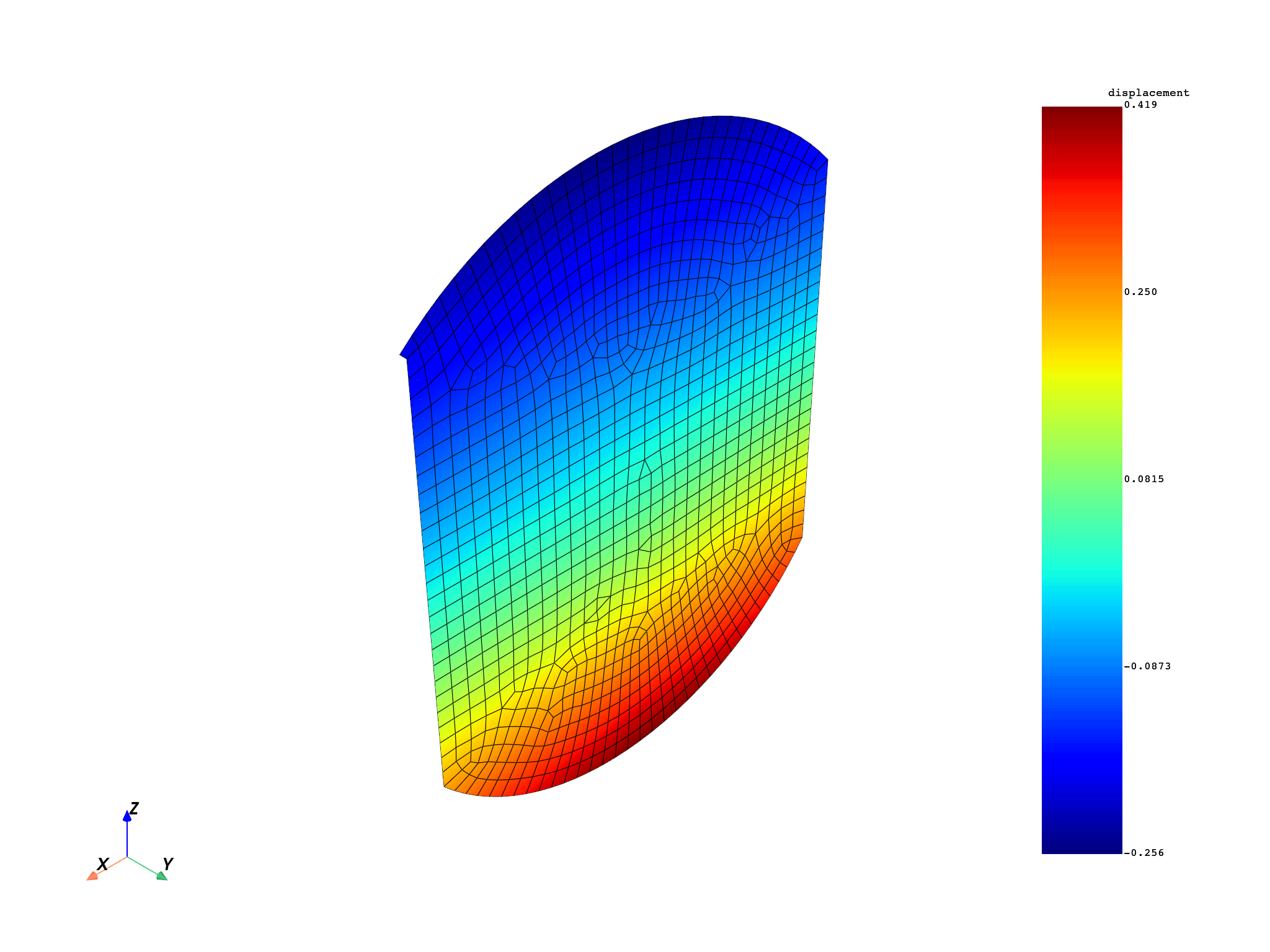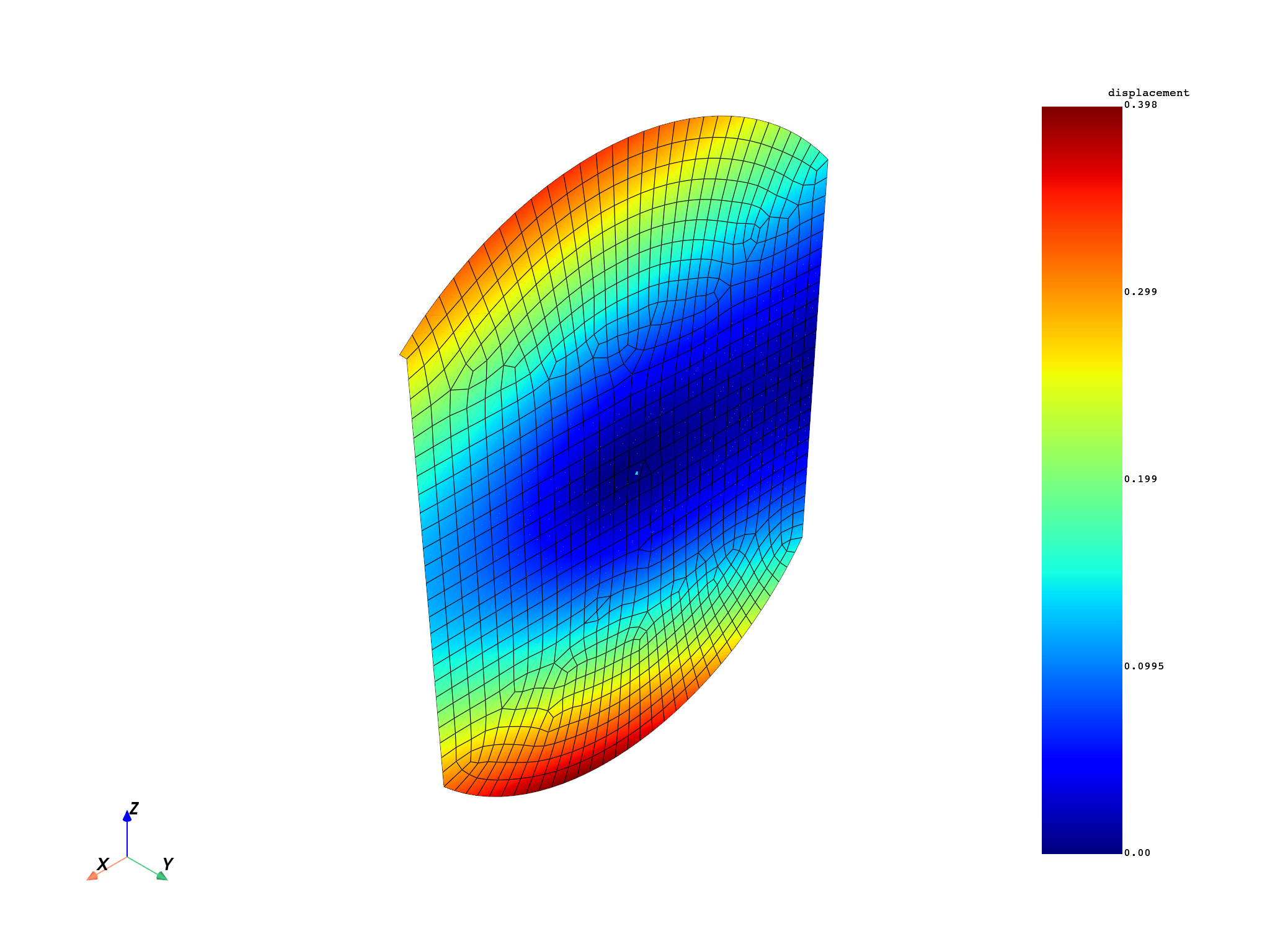Note
Go to the end to download the full example code.
Distributed MSUP distributed modal response#
This example shows how to read and expand distributed files on distributed processes. The modal basis (two distributed files) is read on two remote servers. The modal response (two distributed files) is then read and expanded on a third server.
The following diagram helps you to understand this example. It shows the operator chain that is used to compute the final result.
digraph foo { graph [pad="0", nodesep="0.3", ranksep="0.3"] node [shape=box, style=filled, fillcolor="#ffcc00", margin="0"]; rankdir=LR; splines=line; disp01 [label="displacement"]; disp02 [label="displacement"]; mesh01 [label="mesh"]; mesh02 [label="mesh"]; subgraph cluster_1 { ds01 [label="data_src", shape=box, style=filled, fillcolor=cadetblue2]; disp01; mesh01; ds01 -> disp01 [style=dashed]; ds01 -> mesh01 [style=dashed]; label="Server 1"; style=filled; fillcolor=lightgrey; } subgraph cluster_2 { ds02 [label="data_src", shape=box, style=filled, fillcolor=cadetblue2]; disp02; mesh02; ds02 -> disp02 [style=dashed]; ds02 -> mesh02 [style=dashed]; label="Server 2"; style=filled; fillcolor=lightgrey; } disp01 -> "merge_fields"; mesh01 -> "merge_mesh"; disp02 -> "merge_fields"; mesh02 -> "merge_mesh"; ds03 [label="data_src", shape=box, style=filled, fillcolor=cadetblue2]; ds03 -> "response2" [style=dashed]; ds04 [label="data_src", shape=box, style=filled, fillcolor=cadetblue2]; ds04 -> "response" [style=dashed]; "merge_mesh" -> "response"; "response" -> "merge_use_pass"; "response2" -> "merge_use_pass"; "merge_use_pass" -> "expansion"; "merge_fields" -> "expansion"; "expansion" -> "component"; }Import the dpf-core module and its examples files.
import os
from ansys.dpf import core as dpf
from ansys.dpf.core import examples
from ansys.dpf.core import operators as ops
Configure the servers#
Make a list of IP addresses and port numbers that DPF servers start and listen on. Operator instances are created on each of these servers so that each server can address a different result file.
This example postprocesses an analysis distributed in two files. Consequently, it requires two remote processes.
To make it easier, this example starts local servers. However, you can connect to any existing servers on your network.
config = dpf.AvailableServerConfigs.InProcessServer
if "DPF_DOCKER" in os.environ.keys():
# If running DPF on Docker, you cannot start an InProcessServer
config = dpf.AvailableServerConfigs.GrpcServer
global_server = dpf.start_local_server(as_global=True, config=config)
remote_servers = [
dpf.start_local_server(as_global=False, config=dpf.AvailableServerConfigs.GrpcServer),
dpf.start_local_server(as_global=False, config=dpf.AvailableServerConfigs.GrpcServer),
]
ips = [remote_server.ip for remote_server in remote_servers]
ports = [remote_server.port for remote_server in remote_servers]
Print the IP addresses and ports.
print("ips:", ips)
print("ports:", ports)
ips: ['127.0.0.1', '127.0.0.1']
ports: [50057, 50058]
Specify the file path.
base_path = examples.find_distributed_msup_folder()
files = [
dpf.path_utilities.join(base_path, "file0.mode"),
dpf.path_utilities.join(base_path, "file1.mode"),
]
files_aux = [
dpf.path_utilities.join(base_path, "file0.rst"),
dpf.path_utilities.join(base_path, "file1.rst"),
]
files_rfrq = [
dpf.path_utilities.join(base_path, "file_load_1.rfrq"),
dpf.path_utilities.join(base_path, "file_load_2.rfrq"),
]
Create operators on each server#
On each server, create two operators, one for displacement computations and one for providing the mesh. Then, define their data sources. Both the displacement operator and mesh provider operator receive data from their respective data files on each server.
remote_displacement_operators = []
remote_mesh_operators = []
for i, server in enumerate(remote_servers):
displacement = ops.result.displacement(server=server)
mesh = ops.mesh.mesh_provider(server=server)
remote_displacement_operators.append(displacement)
remote_mesh_operators.append(mesh)
ds = dpf.DataSources(files[i], server=server)
ds.add_file_path(files_aux[i])
displacement.inputs.data_sources(ds)
mesh.inputs.data_sources(ds)
Create a local operator chain for expansion#
The following series of operators merge the modal basis and the meshes, read the modal response, and expand the modal response with the modal basis.
merge_fields = ops.utility.merge_fields_containers()
merge_mesh = ops.utility.merge_meshes()
ds = dpf.DataSources(files_rfrq[0])
response = ops.result.displacement(data_sources=ds)
response.inputs.mesh(merge_mesh.outputs.merges_mesh)
ds = dpf.DataSources(files_rfrq[1])
response2 = ops.result.displacement(data_sources=ds)
response2fc = response2.outputs.fields_container()
response2fc.time_freq_support.time_frequencies.scoping.set_id(0, 2)
merge_use_pass = ops.utility.merge_fields_containers()
merge_use_pass.inputs.fields_containers1(response)
merge_use_pass.inputs.fields_containers2(response2fc)
expansion = ops.math.modal_superposition(
solution_in_modal_space=merge_use_pass, modal_basis=merge_fields
)
component = ops.logic.component_selector_fc(expansion, 1)
Connect the operator chains together and get the output#
for i, server in enumerate(remote_servers):
merge_fields.connect(i, remote_displacement_operators[i], 0)
merge_mesh.connect(i, remote_mesh_operators[i], 0)
fc = component.get_output(0, dpf.types.fields_container)
merged_mesh = merge_mesh.get_output(0, dpf.types.meshed_region)
merged_mesh.plot(fc.get_field_by_time_complex_ids(1, 0))
merged_mesh.plot(fc.get_field_by_time_complex_ids(20, 0))
print(fc)
DPF Fields Container
with 40 field(s)
defined on labels: complex time
with:
- field 0 {complex: 0, time: 1} with Nodal location, 1 components and 1065 entities.
- field 1 {complex: 1, time: 1} with Nodal location, 1 components and 1065 entities.
- field 2 {complex: 0, time: 2} with Nodal location, 1 components and 1065 entities.
- field 3 {complex: 1, time: 2} with Nodal location, 1 components and 1065 entities.
- field 4 {complex: 0, time: 3} with Nodal location, 1 components and 1065 entities.
- field 5 {complex: 1, time: 3} with Nodal location, 1 components and 1065 entities.
- field 6 {complex: 0, time: 4} with Nodal location, 1 components and 1065 entities.
- field 7 {complex: 1, time: 4} with Nodal location, 1 components and 1065 entities.
- field 8 {complex: 0, time: 5} with Nodal location, 1 components and 1065 entities.
- field 9 {complex: 1, time: 5} with Nodal location, 1 components and 1065 entities.
- field 10 {complex: 0, time: 6} with Nodal location, 1 components and 1065 entities.
- field 11 {complex: 1, time: 6} with Nodal location, 1 components and 1065 entities.
- field 12 {complex: 0, time: 7} with Nodal location, 1 components and 1065 entities.
- field 13 {complex: 1, time: 7} with Nodal location, 1 components and 1065 entities.
- field 14 {complex: 0, time: 8} with Nodal location, 1 components and 1065 entities.
- field 15 {complex: 1, time: 8} with Nodal location, 1 components and 1065 entities.
- field 16 {complex: 0, time: 9} with Nodal location, 1 components and 1065 entities.
- field 17 {complex: 1, time: 9} with Nodal location, 1 components and 1065 entities.
- field 18 {complex: 0, time: 10} with Nodal location, 1 components and 1065 entities.
- field 19 {complex: 1, time: 10} with Nodal location, 1 components and 1065 entities.
- field 20 {complex: 0, time: 11} with Nodal location, 1 components and 1065 entities.
- field 21 {complex: 1, time: 11} with Nodal location, 1 components and 1065 entities.
- field 22 {complex: 0, time: 12} with Nodal location, 1 components and 1065 entities.
- field 23 {complex: 1, time: 12} with Nodal location, 1 components and 1065 entities.
- field 24 {complex: 0, time: 13} with Nodal location, 1 components and 1065 entities.
- field 25 {complex: 1, time: 13} with Nodal location, 1 components and 1065 entities.
- field 26 {complex: 0, time: 14} with Nodal location, 1 components and 1065 entities.
- field 27 {complex: 1, time: 14} with Nodal location, 1 components and 1065 entities.
- field 28 {complex: 0, time: 15} with Nodal location, 1 components and 1065 entities.
- field 29 {complex: 1, time: 15} with Nodal location, 1 components and 1065 entities.
- field 30 {complex: 0, time: 16} with Nodal location, 1 components and 1065 entities.
- field 31 {complex: 1, time: 16} with Nodal location, 1 components and 1065 entities.
- field 32 {complex: 0, time: 17} with Nodal location, 1 components and 1065 entities.
- field 33 {complex: 1, time: 17} with Nodal location, 1 components and 1065 entities.
- field 34 {complex: 0, time: 18} with Nodal location, 1 components and 1065 entities.
- field 35 {complex: 1, time: 18} with Nodal location, 1 components and 1065 entities.
- field 36 {complex: 0, time: 19} with Nodal location, 1 components and 1065 entities.
- field 37 {complex: 1, time: 19} with Nodal location, 1 components and 1065 entities.
- field 38 {complex: 0, time: 20} with Nodal location, 1 components and 1065 entities.
- field 39 {complex: 1, time: 20} with Nodal location, 1 components and 1065 entities.
Total running time of the script: (0 minutes 1.190 seconds)

